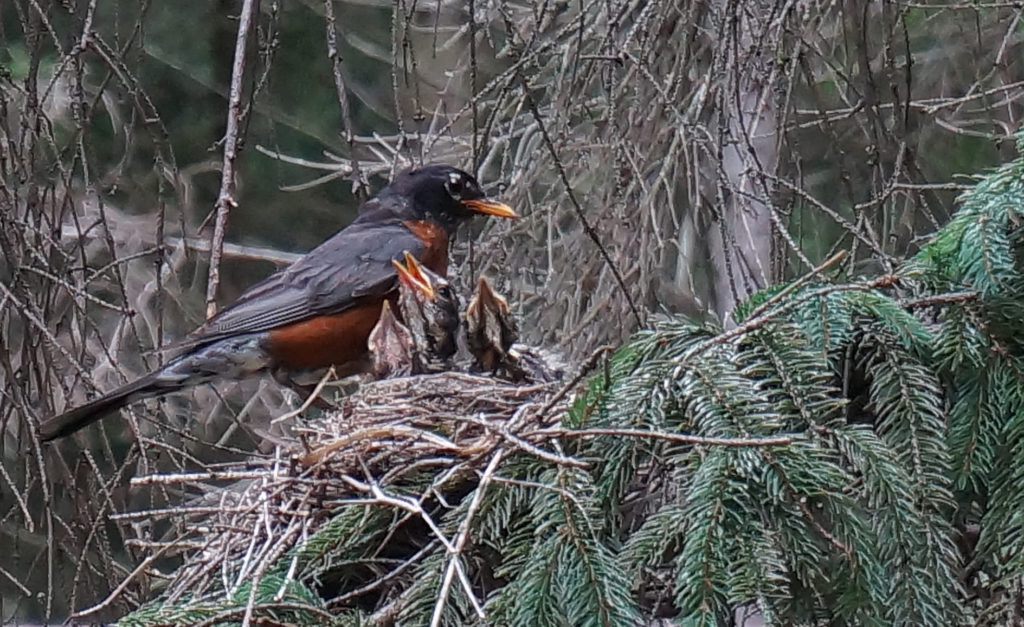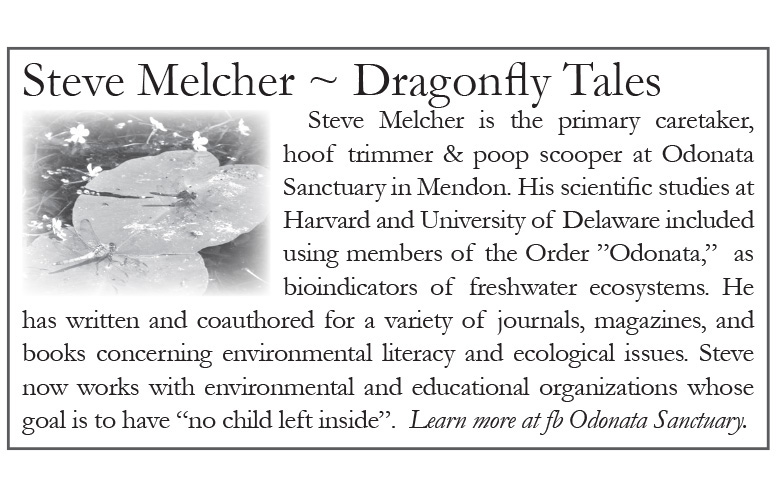Dragonfly Tales
Odonata Sanctuary, The 2020-2024 New York State Breeding Bird Atlas, Phenology, and Signs of Spring

Hey Birders!
One way I encourage families to get outside is through the wonderful hobby of ‘birding’. No longer the realm of the bird watching twitcher in khaki shorts and pith helmet, birding has become the fastest growing outdoor activity in America. More than 45 million people say they watch birds as a hobby according to the findings of a survey produced by the U.S. Fish & Wildlife service, adding nearly $80 billion to the US economy. The COVID-19 pandemic has prevented folks from traveling far and wide in search of adventure so many have chosen to set up a bird feeder and look out their kitchen window and observe the world of evolved dinosaurs.
One extra step you can take as a birder in your very own neighborhood is to become involved in the New York State Breeding Bird Atlas. The atlas occurs, just like pandemics and Harvest moons, on Friday the 13th, every 20 years and this is the third rendition. This atlas will help to improve our understanding of the changes in bird behavior due to climate change.
Henry and Phenology
We know from reading nature essays of the past, like those of Henry David Thoreau, that birds are leaving or arriving sooner or later than they did in the past. Thoreau saw birds that are no longer in his native state of Massachusetts and there are many that are native there now that he never observed. Although Henry, an astute observer, encountered muskrats and foxes in Walden’s woods, he writes, “The bear, wolf, lynx, wildcat, deer, beaver, and marten, have disappeared’. Henry probably never saw Eastern coyotes, Starlings or a Mallard or even a Red Bellied Woodpecker on his daily saunters around Walden Pond. Climate and habitat change are major factors in the shift in what we see today. Thoreau wrote seasonal observations about the blooming of flowers and the arrival of birds in the spring; when they started building nests and when the birds fledged and migrated south again.
The author Louisa May Alcott, a Concord resident, wrote that Thoreau “used to come smiling up to his neighbors, to announce that the bluebirds had arrived, with as much interest in the fact as other men take in messages by the Atlantic cable.”
This science of observing biological events is called Phenology, not to be confused with Andy Vaughn’s ever-popular Phrenology—which measures the bumps on your head to predict your character and mental abilities. An easy phenological event for all of us to observe is the arrival of birds in the spring. Although some Canada Geese may overwinter here in the Finger Lakes, the arrival of skeins of V’s in the sky harbor the beginning of spring. One aspect of phenology is the observation of not just when the birds arrive but their change in behavior. Birds begin singing in the spring…for a reason. That silent cardinal that came to your snow covered feeder is now singing his heart out to claim his territory and set up housekeeping. Interestingly, owls are one of the first birds to mate in our area. By the time you read this in May, bluebirds are busy laying eggs but Eastern Screech Owls have already fledged. Warblers have arrived with the blooming of the hawthorns and the abundance of insects. Redwing Blackbirds and Tree Swallows are still dive bombing you when you get too close to their nest. Birds sing their songs of spring to attract a mate, defend their territory or maybe, just because the juices are flowing and singing is the best way to get it all out.
What are your harbingers of spring? Have they changed since your childhood? Was it the first Monarch Butterfly or Ruby Throated Hummingbird, or perhaps the first daffodil or Trout Lily? The return of the robins and bluebirds was always a sign for me but they are here year round now. Their behavior changes in the winter though. Robins will gather together in nomadic flocks during the winter searching for fruits such as crabapples, hawthorns, holly, and juniper. Then, if you pay attention, you’ll see their behavior change. In the spring, robins disperse from their flocks and resume their diet of bugs and worms. Many robins will still migrate up from the South, males arriving a few days ahead of the females, eager to start a new family.
Timing is so important and shows us how nature is intricately interconnected. What if an insect eating bird arrives before the insects? What if flowers haven’t bloomed yet and the insects have hatched and there is no pollen to pollinate? A wonderful example of phenological timing is the relationship between a marine arthropod that hasn’t changed in 450 million years and shorebirds that I studied on the Eastern Shore back in the 70’s. The horse shoe crab spawns on the beaches of the Delaware Bay and the Red Knot depends on unearthing the eggs as fuel to continue their 4,000 mile journey. If the horseshoe crabs don’t show up at the right time, the shorebirds starve and population plummets. We called this a ‘phenological disruption’. Today, the phenomena is known as ‘Phenological Mismatch’. In today’s world of climate change awareness we are realizing that the shifts in climate are disrupting interspecies synchrony with detrimental consequences to ecosystems. For instance, most of our food depends on pollinators arriving at the right time to do their job. If the timing is ‘disrupted’ by increasing catastrophic weather, in the future, we may not have fresh food on our table that season.
This winter we had a ‘superflight’ of hungry winter finches. Every species of boreal finch ‘irrupted’ (a sudden change in the population density) and researchers are calling this year a ‘superflight’. Pine Grosbeaks, Pine Siskins, Crossbills and Hoary Redpolls moved south in search of food along with many other birds like Blue Jays, Bohemian Waxwings and Red Breasted Nuthatches. What caused the lack of food in the North? One theory is that trees evolved to cycle their mast-crop production (fruit of the forest trees and shrubs such as nuts, seeds and acorns) in order to limit the food supply of seed eating squirrels, preventing overpopulation resulting in the squirrels eating all the seeds. Unlike squirrels, fortunately birds can fly south long distances in search of another restaurant.
Awareness is a key
Awareness and Observation follow each other. Maybe you can observe without being aware, I’m not sure. But you can observe without knowing. You can observe a bird or plant blooming without knowing the species of bird (there are amazing aps for this – Merlin and iNaturalists are just two). Awareness is key; it’s the starting point. Bill Drury’s mantra, professor of ornithology at Harvard, was to ‘Pay Attention!’. In other words ‘engage’. The pandemic, according to the ‘Medical News Today’, has significantly increased the time folks spend outdoors. If you’re spending time outdoors why not engage in nature and pay attention. We’re fortunate to have four glorious seasons, each with their own ways of saying hello and goodbye. If we pay attention and wait for the return of the Barn Swallows, we’ll become more aware of the tragedy of not seeing the swallows return and demand to know why. Citizen scientists, paying attention, and recording those seasonal events (phenology), have become valuable tools in understanding our changing climate. By recording what we see and hear now compared to what we heard and saw helps us plan for a future; a future that depends on folks that care enough to pay attention.
A Skein in the Sky – Why Geese Fly in a V
If you notice a flock of geese flying in a V shape (known as a skein) overhead you may see the leader shift from time to time. They all know they way, they are just taking turns leading. When the vanguard in the V gets tired he or she takes a break and another goose takes over so the skein may look like it’s constantly shifting. Researchers have found that the birds will share the tiring lead position in their V formations. Just like cars racing around a track, the bird following another gets a little extra lift from the wake of the bird in front of them. You may have also noticed that one side of the V is usually longer than the other. This was determined by scientists at MIT (Joseph Rosenshein) to be a mathematical phenomena due to the correlation between the number of geese and the length of the side of the V.
“One swallow does not make a summer, but one skein of geese, cleaving the murk of a March thaw, is the spring. … By this international commerce of geese, the waste corn of Illinois is carried through the clouds of the Arctic tundras, there to combine with the waste sunlight of a nightless June to grow goslings for all the lands between. And in this annual barter of food for flight, and winter warmth for summer solitude, the whole continent receives as net profit a wild poem dropped from the murky skies upon the muds of March.” ~ Aldo Leopold, “March,” in “A Sand County Almanac”
NYSBBA – New York State Breeding Bird Atlas
New York is divided up into over 5,000 atlas blocks, each roughly 3×3 miles square. We need help from birders–beginners and seasoned–to complete the inventory over the next five years. Odonata Sanctuary is located in a Priority Block called Honeoye Falls CE. Several beginners as well as ‘elder twitchers’ have helped count species and look for signs that that a species is actually nesting in our block. For more information on how you can get involved go to the Breeding Bird Atlas website at: ebird.org/atlasny/about.
